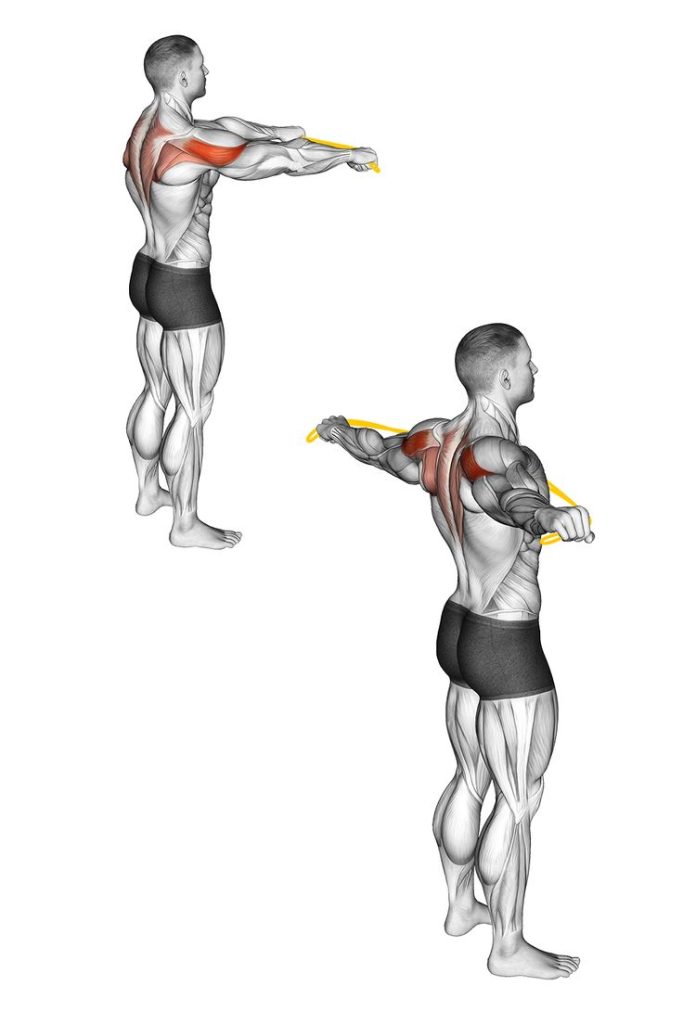2 de June de 2025
Band Pull-Aparts: Exercise Guide, Tips and Benefits
Band pull-aparts are one of the simplest yet most effective resistance band exercises for improving shoulder health, posture, and upper-back strength. Whether you’re a beginner or an experienced lifter, this exercise can easily fit into your warm-up, rehab protocol, or strength and conditioning routine. With just a resistance band, you can build scapular stability and improve muscle activation in your posterior chain.
What Are Band Pull-Aparts?
Band pull-aparts are a resistance band exercise targeting the muscles of the upper back and shoulders. Performed by pulling a resistance band apart across your chest, this movement reinforces scapular retraction and postural alignment. It’s low-impact, easy to scale in difficulty, and ideal for both mobility sessions and upper-body training days.
This exercise is commonly used in physical therapy, athletic training, and corrective movement programs to enhance joint health, shoulder mechanics, and muscular endurance. It’s especially beneficial for those who spend long hours seated or hunched forward.
How to Do Band Pull-Aparts Properly
- Choose your band: Use a light or medium-resistance band to begin. Loop-style bands are ideal.
- Stand tall: Keep your feet hip-width apart, shoulders back, and core lightly engaged.
- Hold the band: Extend your arms straight in front of you at shoulder height, holding the band with an overhand grip and tension in the band.
- Pull apart: Keeping your arms straight, pull the band outward by squeezing your shoulder blades together.
- Control the return: Slowly return to the starting position without letting the band snap back.
- Maintain form: Avoid shrugging or bending your elbows. Keep movement smooth and deliberate.

Muscles Worked by Band Pull-Aparts
Band pull-aparts activate several upper-body muscles that are often underused in traditional training:
- Rear deltoids: Key for shoulder stability and balanced deltoid development.
- Rhomboids: Responsible for pulling the shoulder blades together.
- Trapezius (middle and lower fibers): Help stabilize and retract the scapula.
- Rotator cuff: Engaged for joint integrity and shoulder health.
- Erector spinae and core: Assist in maintaining upright posture during the movement.
These muscles work together to support better shoulder function, reduce injury risk, and improve postural strength.
Benefits of Band Pull-Aparts
- Improved posture: Strengthens the muscles that oppose forward-leaning positions and tech-neck.
- Shoulder health: Enhances joint stability and control, making it a staple in rehab and prehab programs.
- Scapular strength: Reinforces scapular retraction, crucial for pressing and pulling exercises.
- Accessibility: Requires minimal equipment and space—great for home workouts or travel routines.
- Balanced development: Helps counteract imbalances caused by excessive pressing or sitting.
Band pull-aparts are also an excellent fatigue management tool. Their low-impact nature allows for high-frequency use without overloading the nervous system.
Common Mistakes to Avoid
- Shrugging shoulders: Keep traps relaxed and focus on shoulder blade movement.
- Bending the elbows: The arms should stay extended throughout the rep.
- Too much resistance: Start light to prioritize range of motion and control.
- Rapid reps: Use a steady tempo to enhance muscle activation and control.
- Leaning back: Stay tall and don’t use momentum to complete the movement.
Variations of Band Pull-Aparts
- Overhead Band Pull-Aparts
Start with the band overhead and pull it down behind your head, engaging the upper back and lats. - Horizontal Band Pull-Aparts (Palms Up)
Perform the movement with an underhand grip to target the lower traps and posterior delts differently. - Diagonal Pull-Aparts
Pull the band in a diagonal motion from shoulder to hip to engage core and obliques alongside upper back muscles. - Wall-Supported Pull-Aparts
Stand with your back against the wall for feedback on posture and range of motion. - Isometric Holds
Pause at the end range for 5–10 seconds per rep to build endurance and scapular stability.
How to Include Band Pull-Aparts in Your S&C Workout
Add 2–4 sets of 12–20 reps of band pull-aparts to your warm-up, mobility, or accessory block. They pair well with compound lifts like rows and presses to improve shoulder mechanics and reduce compensatory patterns. For rehab or postural correction, you can perform them daily using higher reps and lower resistance.
FAQs About Band Pull-Aparts
What muscles do band pull-aparts work?
They primarily work the rear delts, rhomboids, middle traps, and rotator cuff—essential for posture and shoulder stability.
How many reps of band pull-aparts?
12–20 reps per set is ideal. You can perform them daily with light resistance for volume and activation.
What are the benefits of overhead band pull-aparts?
They activate the lats, upper back, and scapular stabilizers more intensely and are great for shoulder mobility.
Do band pull-aparts improve posture?
Yes, they target the muscles responsible for maintaining an upright posture and counteract the effects of prolonged sitting.
Can I do band pull-aparts every day?
Yes. They’re low-impact and effective as a daily corrective or mobility drill.
Do band pull-aparts work the rotator cuff?
Yes—they support shoulder joint integrity and are commonly used in rehab and prehab routines.
Simple but powerful, band pull-aparts are a must-have for any well-rounded training program. They’re effective, joint-friendly, and help bulletproof your shoulders. Add them to your strength and conditioning routine to support better posture, pressing strength, and long-term shoulder health.
